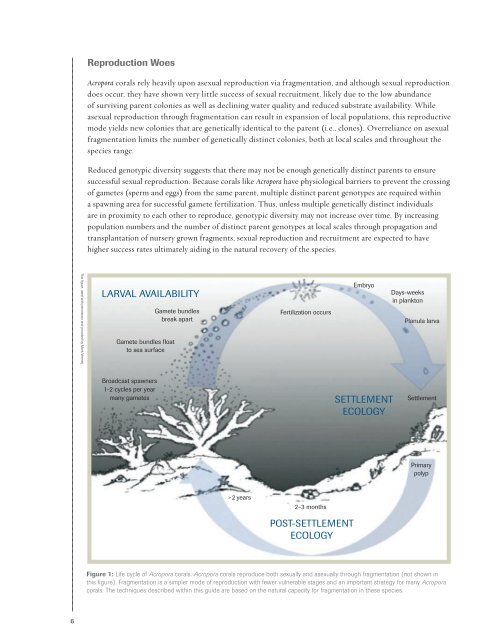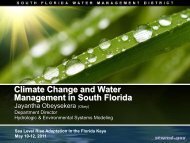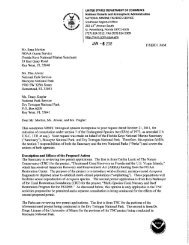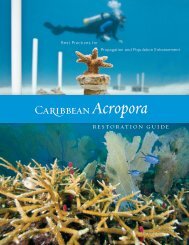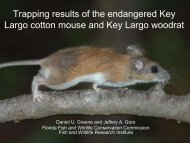Caribbean Acropora Restoration Guide - The Florida Reef ...
Caribbean Acropora Restoration Guide - The Florida Reef ...
Caribbean Acropora Restoration Guide - The Florida Reef ...
Create successful ePaper yourself
Turn your PDF publications into a flip-book with our unique Google optimized e-Paper software.
Reproduction Woes<br />
<strong>Acropora</strong> corals rely heavily upon asexual reproduction via fragmentation, and although sexual reproduction<br />
does occur, they have shown very little success of sexual recruitment, likely due to the low abundance<br />
of surviving parent colonies as well as declining water quality and reduced substrate availability. While<br />
asexual reproduction through fragmentation can result in expansion of local populations, this reproductive<br />
mode yields new colonies that are genetically identical to the parent (i.e., clones). Overreliance on asexual<br />
fragmentation limits the number of genetically distinct colonies, both at local scales and throughout the<br />
species range.<br />
Reduced genotypic diversity suggests that there may not be enough genetically distinct parents to ensure<br />
successful sexual reproduction. Because corals like <strong>Acropora</strong> have physiological barriers to prevent the crossing<br />
of gametes (sperm and eggs) from the same parent, multiple distinct parent genotypes are required within<br />
a spawning area for successful gamete fertilization. Thus, unless multiple genetically distinct individuals<br />
are in proximity to each other to reproduce, genotypic diversity may not increase over time. By increasing<br />
population numbers and the number of distinct parent genotypes at local scales through propagation and<br />
transplantation of nursery grown fragments, sexual reproduction and recruitment are expected to have<br />
higher success rates ultimately aiding in the natural recovery of the species.<br />
This figure, used with permission and provided by Mark Vermeij<br />
LARVAL AVAILABILITY<br />
Gamete bundles float<br />
to sea surface<br />
Gamete bundles<br />
break apart<br />
Fertilization occurs<br />
Embryo<br />
Days-weeks<br />
in plankton<br />
Planula larva<br />
Broadcast spawners<br />
1-2 cycles per year<br />
many gametes<br />
SETTLEMENT<br />
ECOLOGY<br />
Settlement<br />
Primary<br />
polyp<br />
> 2 years<br />
2–3 months<br />
POST-SETTLEMENT<br />
ECOLOGY<br />
Figure 1: Life cycle of <strong>Acropora</strong> corals. <strong>Acropora</strong> corals reproduce both sexually and asexually through fragmentation (not shown in<br />
this figure). Fragmentation is a simpler mode of reproduction with fewer vulnerable stages and an important strategy for many <strong>Acropora</strong><br />
corals. <strong>The</strong> techniques described within this guide are based on the natural capacity for fragmentation in these species.<br />
6


